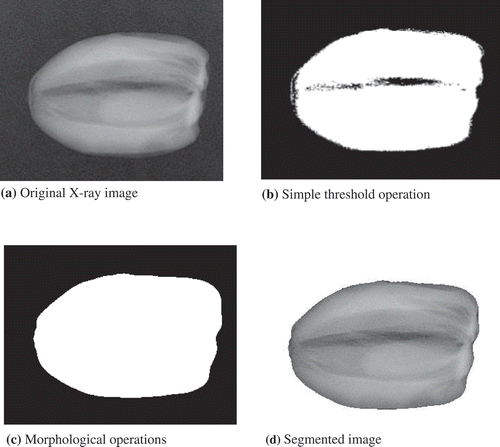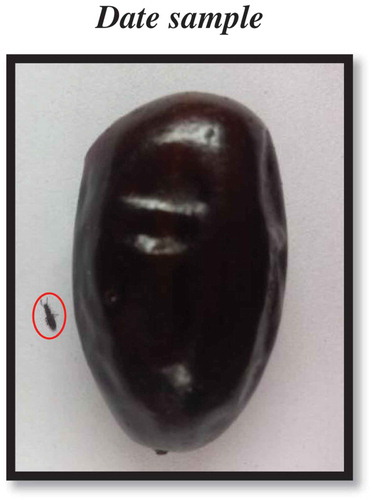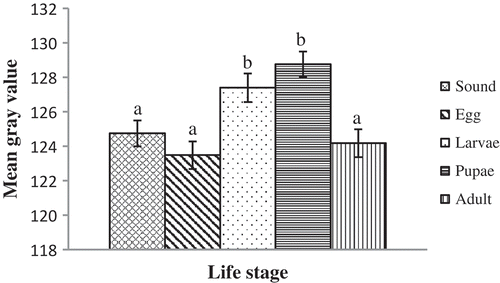ABSTRACT
The objective of this study was to investigate the capability of X-ray imaging in detecting internal infestations caused by the saw-toothed beetle (Oryzaephilus surinamensis L.) in stored dates. Un-infested and infested dates were x-rayed for different life stages (egg, larvae, pupae, and adult) of O. surinamensis. An algorithm was developed to extract 44 features from the X-ray images. Linear discriminant analysis (LDA) was used to discriminate the un-infested and infested dates using extracted features. Overall accuracy of X-ray imaging system was 80% for un-infested and beetle-infested dates. X-ray imaging system yielded around 97% accuracy in detecting internal infestation of dates with an adult beetle while using a pairwise classification method. Further studies are required to investigate the effects of moisture content and hardness of dates in the discrimination between the un-infested and infested dates.
Introduction
Insect infestation is a significant factor that affects the quality of stored products. It lowers marketing and nutrition of affected products (Neethirajan et al., Citation2007) and may result in up to 50% losses of the stored product (Fornal et al., Citation2007). In addition to the physical losses arising from consumption of stored products by insects, the presence of metabolic byproducts and insect fragments contribute to downgrading and rejection of the affected product during marketing because they do not meet quality standards. Affected products also provide a source of contaminants to other stored food products.
Oman is considered one of the major date producers in the world. It produced approximately 276,400 MT of dates in Citation2010 (FAO, Citation2010). About 60–70% of the production is stored in dried form for later consumption (Al-Abid et al., Citation2007). Dates in general, suffer considerable quality losses due to insect infestation during storage, which lowers nutritional and market values. Severe infestation makes the dates undesirable for human consumption, particularly exported dates. While different varieties of dates are susceptible for various levels of infestation, the Fardh variety is the most affected by insect attacks in Oman (Al-Zadjali et al., Citation2006).
The saw-toothed beetle (Oryzaephilus surinamensis Linnaeus) is a pest of stored dates in Oman with an average infestation rate of 34.6% (Al-Mjeni et al., Citation1983; Al-Zadjali et al., Citation2006). Al-Abid et al. (Citation2007) also reported that insect infestation caused by this beetle is a critical problem in date storage facilities and factories in Oman. In an effort to counter this problem, Oman has applied strict regulations with regard to date infestation such that insects and their residues should not exceed 6% (Omani Standard, Citation1988; Al-Abid et al., Citation2007).
Detection and treatment are the two key factors in monitoring and controlling insect infestation in dates during storage and processing. Fumigation is the most commonly used method to eliminate or reduce insect infestations in stored products. However, methyl bromide, the chemical used for fumigation in dates in many countries, is known to have adverse effects on the ozone layer (Al-Abid et al., Citation2007; Hashem et al., Citation2012) and its usage has been banned (Hansen and Jensen, Citation2002). Before treatment with insecticides, it is important to assess the degree of infestation. The presence of insects in date fruits is usually detected by visual inspection. However, this method is time consuming and sometimes inaccurate (Jiang et al., Citation2008). During visual inspection, most of the internal insect infestations cannot be detected, especially when there are no signs of infestation on the surface (Nawrocka et al., Citation2010). As such, there is an urgent need to establish reliable methods to detect internal infestation in dates.
Many efforts have been made to use computer vision technology for external and internal quality inspection in the food industry (Brosnan and Sun, Citation2002; Neethirajan et al., Citation2007). Thermal imaging can detect the internal insect infestation in wheat kernel without specifying the developmental stages (Manickavasagan et al., Citation2008). Near-infrared method is rapid in detecting both external and internal insect infestation in grain and does not require sample preparation. However, this method cannot detect low levels of infestation (Neethirajan et al., Citation2007), requires frequent and complex calibration (Dowell et al., Citation1998; Neerthirajan et al., Citation2007; Pearson et al., Citation2003), and cannot differentiate between live and dead insects (Dowell et al., Citation1999; Karunakaran et al., Citation2002a, Citation2002b). Magnetic resonance imaging (MRI) offers information about the internal structure of the objects. Its possible uses for detecting internal infestation and insect damage as well as internal defects in kiwifruit, cucumber, and potato are being investigated (Ruiz-Altisent et al., Citation2010; Zerbini, Citation2006). It is more expensive than the other imaging technologies, and the implementation of MRI technology in industry is considered to be difficult (Ruiz-Altisent et al., Citation2010). X-ray imaging has great potential in detecting external and internal insect infestation (Fornal et al., Citation2007; Karunakaran et al., Citation2003, Citation2004a; Nawrocka et al., Citation2010), but there are no reports available in the public domain for detecting insects in dates using X-ray imaging.
The objective of this study was, therefore, to investigate the potential use of X-ray imaging to detect internal infestations of four life stages (egg, larval, pupae, and adult) of Oryzaephilus surinamensis in dates.
Materials and methods
Insect culture preparation
Healthy O. surinamensis adults were obtained from the Entomology Laboratory, College of Agriculture and Marine Science, Sultan Qaboos University, Oman. They were reared on dry dates and kept inside a dark incubator (MLR-351H, SANYO Electric Co., Ltd., Moriguchi City, Osaka, Japan) maintained at a temperature of 30 ± 1°C and a relative humidity of 70 ± 5%, conditions considered to be the most suitable for insect development (Al-Abid et al., Citation2007; Halstead, Citation1980; Hashem et al., Citation2012). For about 7 months, the life cycle of the insect was studied to determine the duration (number of days) for each life stage. Stages were monitored daily using a microscope (VM series, Olympus Stereo Microscopes, Tokyo, Japan) by examining the insect starting with the egg stage (). Eggs hatched into the first larval stage approximately after 4 days, and larvae took 16 days to reach the pupal stage. The pupae took about 5 days to develop into adults. All of the stages were kept in the same controlled environment.
Sample preparation
Dried date samples of the Fardh variety were procured from Bright Sun Dates Company (Barka, Oman). A total of 40 clean dates free from physical damage and injury (i.e., “sound dates”) were selected for use in this study. X-ray images of these un-infested dates were taken. The eggs of O. surinamensis were obtained by placing adult beetles in a white flour medium for 24 h. The eggs were taken using a soft brush and used to artificially infest 40 un-infested dates by inserting one egg per each date sample into a hole made on the surface of the dates. The microscope was used to ensure that the egg was placed without any damage. The infested date samples were X-rayed on the 1st, 20th, 25th, and 27th days for egg, larvae, pupae, and adult, respectively. During the experiment, infested dates were incubated at 30 ± 1°C, 70 ± 5% relative humidity, and 0 LS (Light step 0: all lamp OFF), the same conditions used in rearing the insect.
X-ray image acquisition
X-ray images of the dates were acquired at 40 kV potential and 1.6 mAs current using an X-ray machine (DigitalDiagnost TH, Philips Medical Systems, Holanda, Holland, Netherlands) at the Sultan Qaboos University Hospital, Oman. A single date was placed on the platform. The source image distance (SID) from the X-ray tube on the platform was fixed at 47 mm. X-ray images with a resolution of 512×512 were stored in a digital diagnostic workstation computer and then were transferred to a personal computer for further analyses.
Algorithm development and data analysis
An algorithm for processing the acquired X-ray images was developed using MATLAB (Version 7.6.0, The Mathworks Inc., Natick, MA, USA). The steps followed in processing the images are illustrated in . The simple threshold was applied for image segmentation (Gonzalez and Woods, Citation1998; Karunakaran et al., Citation2004b). However, some parts of the dates sampled had similar gray values as the platform, and during thresholding, these parts were classified as background. To solve this problem, several morphological operations (such as “imdilate” and “imopen”—built-in functions in MATLAB software) as well as “hole filling” were employed (). After the object (fruit) was segmented from the background, a total of 44 histogram and textural features were extracted. The histogram features that were extracted are total gray value, mean gray value, standard deviation of gray levels, area of fruit, and minimum gray value (). The histogram of each X-ray image (which overall had gray values in the range 0 to 230) was subdivided into 23 groups with intervals of 10 gray values. Each histogram group from 8–17 (corresponding to grey values 70–169, which had the highest pixels) were also subdivided into subintervals of 5 gray values in order to see more details. Textural features were obtained using gray level co-occurrence matrix (GLCM) method in which the image is converted into a matrix by calculating the frequent occurrence of each pair of adjacent pixels in the image (Gonzalez et al., Citation2011). The textural features were mean, variance, contrast, energy, maximum probability, and entropy ().
Table 1. Histogram and Textural Extracted Features from X-ray Images.
All extracted features were used as inputs for the SPSS statistical software (SPSS Software, IBM Corporation, Armonk, New York, USA) in order to classify the un-infested and infested dates using linear discriminant analysis (LDA) and stepwise discriminant analysis (SDA) (Zhou and Wang, Citation2011). In SDA, the classification accuracies were determined by automatic selection of the most contributing features. Furthermore, we used the bootstrapping method for a discriminatory point of view to overcome two problems: limited number of samples and high cost of X-ray images. Bootstrap technique employs resampling based on the existing data (Efron, Citation1979).
Results and discussion
Survival to adult stage in infested dates
In this study, only 16 out of 40 inserted eggs successfully reached the adult stage. This may be due to injury to the eggs during the process of artificial infestation (Karunakaran et al., Citation2004b) or because of the unsuitability of the environment in the date for egg development or for newly hatched larvae, possibly due to inappropriate moisture levels (Ashby, Citation1961; Karunakaran et al., Citation2004c).
Visual comparisons
The X-ray images of infested dates with O. surinamensis in different life stages taken sequentially are presented in . In general, no beetle at any life stage could be detected in the visual examination of X-ray images of dates. However, in some images, feeding areas could be identified from the presence of darker spots (). Thus, distinguishing between infested dates with different life stages and un-infested dates could not be done visually from the X-ray images. In contrast, the infestation in wheat was clearly visible in X-ray images () (Karunakaran et al., Citation2004a, Citation2004c).
Figure 3. X-ray images of two dates infested with O. surinamensis at different life stages. Sample 1: infestation could not be visually recognized; Sample 2: feeding area was recognizable by dark spots (in red circles).
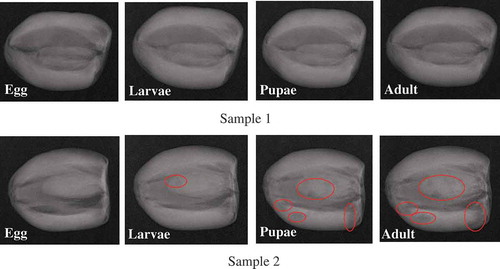
Figure 4. X-ray images of a wheat kernel infested by different life stages of R. dominica (Karunakaran et al., Citation2004a) and date infested by different life stages of O. surinamensis.
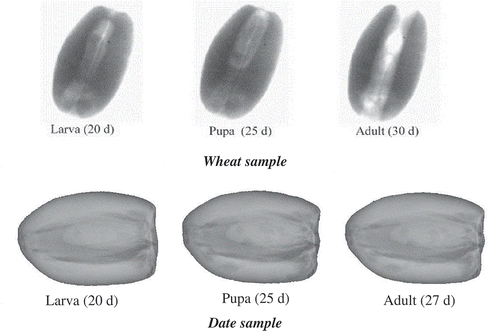
The reason for inability to distinguish O. surinamensis in the X-ray images may be due to the size of the life stages of this insect (almost 1–2.5 mm), being too small compared to the size of the date fruit (about 2–4 cm) (). This makes the amount of consumption by a single insect negligible and, therefore, the effect on the X-ray transmittance undetectable. However, in the wheat kernel, the size of the insect is approximately half or two-thirds the size of the kernel. Thus, the consumption is highly significant in volume and easily detectable on the X-ray images.
Mean gray value
The mean gray value represents the average density of the X-rayed object (Karunakaran et al., Citation2004a). When X-ray images of dates were analyzed, there were clear significant differences in the mean gray values (α = 0.05, n = 16) between the un-infested and dates infested with a larva and a pupa (). However, there were no significant differences between the un-infested and infested dates with an egg and an adult. Also, there was no significant difference between the pupae and larvae stage of infested dates. The mean gray values of adult-infested dates are low compared to dates infested with a larva or a pupa. That the O. surinamensis adult tends to feed more than the larva and the non-feeding pupa, possibly allows for high penetrate of X-ray photon energy into the date, and results in decreasing the gray level. Overall, mean gray level variations in this current study did not follow the expected pattern where the mean gray value should increase gradually through all life stages, as happens with the mean gray values in studies of infested wheat (Karunakaran et al., Citation2004c).
Classification model
Four classes model
The infested dates (larva, pupa, and adult) were classified independently along with un-infested dates. The correctly classified percentages obtained by the LDA and SDA are presented in . Mean gray value and H4 (histogram number 4) were recognized as significant contributing features in the SDA for discrimination purposes.
Table 2. Discrimination Accuracies (%) of Un-infested and Infested Dates in Four Classes Model.
The classification accuracies of most classes were increased due to bootstrapping (). Mean gray value, minimum gray value, histogram groups number (H3, H4, H7, H8-2, H9-1, H9-2, H10-2, H11-1, H11-2, H12-1, H14-2, H15-2, H16-1, H16-2, H17-1, H17-2, H20), variance (GLCM), and contrast were selected in the SDA analyses to be the more dominated features than other extracted features in the classification process.
Two-classes model
The dates infested with larval, pupal, and adult stages were combined together into one group as “infested dates.” The classification results for un-infested and infested dates obtained from LDA and SDA analyses are given in . Histogram group (H16_2) was selected as the most dominant feature. The bootstrapping method resulted in minimum misclassification of about 1% for both analyses, and contributing features included: minimum gray value, histogram groups (H3, H6, H16-2, H17-1, H20), variance (GLCM), and contrast, which were entered in the SDA analyses. The numbers of selected features to enter in the SDA analysis were slightly decreased in the two-classes model compared to the four-classes model. This demonstrated that less features were required for discrimination as the number of classes decreases.
Table 3. Discrimination Accuracies (%) of Un-infested and Infested Dates in Two Classes Model.
From the above two models of classification, significantly higher classification accuracies were obtained through LDA using all extracted features rather than SDA that selects the features with significant contribution. An overall classification accuracy of more than 80% was identified for all cases of un-infested and infested dates with O. surinamensis using LDA.
On the other hand, the classification accuracies of 100% were identified for un-infested wheat and about 99% for wheat infested with Rhyzopertha dominica at the larval stage using a linear discriminant classifier (Karunakaran et al., Citation2004a). In contrast, the high misclassification for infested dates may be due to the natural existence of internal cavities or delamination (defined later) areas on the dates that caused darker areas (), as opposed to wheat, which is denser, and without any cavities or delamination.
Figure 7. X-ray image for skin delamination and dark cavity that affect the classification accuracies of un-infested and infested dates.
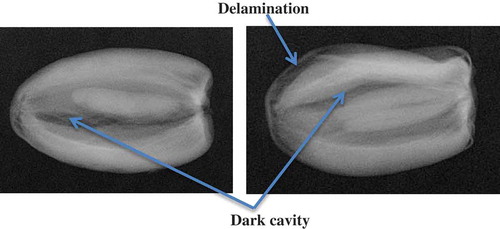
Furthermore, the histogram-based features were found to be more contributive than textural features for discrimination between un-infested and infested dates. These significant features, however, only attributed to about half the classification accuracies, with the rest being attributed to other types of features. This finding agrees with Karunakaran et al. (Citation2004a) in which classification accuracies were higher if using all of the histogram and textural extracted features rather than if each feature was tested separately.
Pairwise classification
The classification accuracies for pairwise classification, which correctly identified the type of infestation of two classes at a time using LDA, are given in . The highest classification accuracy was identified for un-infested-adult pair and the maximum misclassification (6.3%) happened to the rest of pairs. Using bootstrapping, the pairwise identified almost similar classification accuracies for all pairs of investigation except for un-infested-adult pair in which there was 2% misclassification ().
Figure 8. Pairwise classification for un-infested and infested dates with all O. surinamensis life stages (n = 16) with LDA.

Figure 9. Pairwise classification for un-infested and infested dates with all O. surinamensis life stages (n = 100) using bootstrapping with LDA.
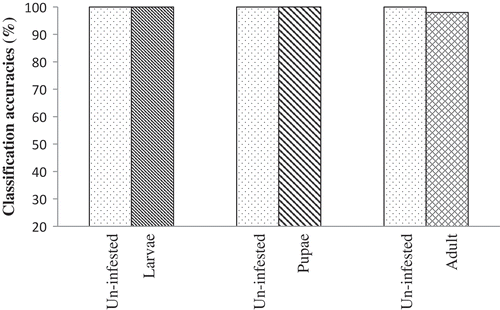
Even though some possibility of identification of insect infested dates using the X-ray imaging technique were apparent from this study, in order to achieve 100% classification of un-infested and infested dates, much more improvement is necessary. Since allowing at least 1% of infested dates to enter dates industry or storage will lead to re-infestation and spread of contamination to other healthy dates, higher classification accuracies are required. The steps suggested for improving the performance of the technique are described in detail in the next section.
Limitations
Several factors have to be taken into account for further investigations of the use of X-ray imaging to detect insect infestation in dates because these factors may affect the gray levels of the X-ray images and, thus, lead to misclassification between un-infested and infested dates. These factors include: skin delamination, internal cavity, moisture, hardness, maturity stage, and seed size.
Skin delamination and internal cavity
Skin delamination is the outer skin of the date that separates from the flesh. The internal cavity is the space within the dates that occur between the seed and flesh. These two factors affect the gray value of the X-ray images, and both are not uniform in all dates. The effect of skin delamination is highlighted in where X-ray images of dates with no, low, and high delaminations are shown. It is obvious that un-infested dates with low to high delamination will have dark areas on the X-ray image, a situation that could lead to incorrectly classifying such dates as infested. The effect of the internal cavity within date fruits () is similar to the effect of the skin delamination in terms of misclassifying un-infested dates as infested dates. The problems of skin delamination and internal cavity (or empty space) are not found (or are negligible) in grains since grains are denser have no outer skin, and there is no internal cavity within.
Moisture content, hardness, seed size, and maturity level
The gray level of the X-ray images is also affected by the variation of the moisture and hardness of the dates. The stored dates have varying moisture content less than 30% (Kader and Hussein, Citation2009) and three categories of hardness: soft, semi hard, and hard (Al-Janobi, Citation2000). These variations among the stored dates may lead to misclassification between the infested and un-infested dates. Additionally, the size of the seed is different from one date to another. Because the date seed appears to be bright (), it may affect the gray value. Furthermore, the date fruits in the same bunch do not undergo the same ripening stage at the same time (Ait-Oubahou and Yahia, Citation1999). This variation in the maturity level may affect the chemical composition of the date fruit, which in turn may affect the gray value of the X-ray images.
Recommendations for future research
In the present study, X-ray machine with relatively lower resolution (512×512 pixels) was used. However, there are X-ray machines with high-resolution available in the market. Also, a 3D X-ray device is being used in non-destructive product testing (North Star Imaging Inc., Citation2015). Therefore, the potential of high resolution and 3D X-ray imaging systems in detection of insect infestation in dates must be investigated.
The effect of improvement in image analysis and algorithms on classification accuracy must be analyzed further. For example, “modified mean gray value” might help in discarding skin delamination and internal cavity area that influence the detection accuracy.
Alternate methods, such as ultrasound imaging or combination of ultrasound and X-ray, should be tested for their efficiency to detect the infestation in dates.
Conclusion
Histogram features contribute more than textural features in the discrimination between un-infested and infested dates. The X-ray imaging technique can detect infestation by O. surinamensis with overall classification accuracies of more than 80% using all extracted features. The highest correctly classified percentage of 96.9% was achieved in a pairwise method between the un-infested dates and dates infested with an adult. Further studies are required to investigate the effect of date moisture content and hardness on the ability to detect the presence of insect pests.
Funding
We thank The Research Council (TRC) of Sultanate of Oman for funding this study (Project No. RC/AGR/SWAE/11/01—Development of Computer Vision Technology for Quality Assessment of Dates in Oman).
Additional information
Funding
Literature cited
- Ait-Oubahou, A., and M.E. Yahia. 1999. Postharvest handling of dates. Postharv. News. Info. 10:67N–74N.
- Al-Abid, M., U. Gohs, M. Al-Farsi, M. Al-Amri, and F. Al-Rawahi, 2007. Disinfestation of dates using electron beams in comparison with other treatments, p. 367–376. In: Proceedings of the International Conference on Date Palm Production and Processing Technology. Ministry of Agriculture and Fisheries publications, Sultanate of Oman.
- Al-Janobi, A.A. 2000. Date inspection by color machine vision. J. Agric. Sci. 12:69–79.
- Al-Mjeni, A.A., A.M. Mokhtar, and M. Al-Mursi. 1983. Stored date insect pests and its control. Ministry of Agriculture and Fisheries, Sultanate of Oman.
- Al-Zadjali, T.S., F.F. Abu-Allah, and H.S. El-Haidari. 2006. Insect pests attacking date palms and dates in Sultanate of Oman. J. Agr. Res. 84:51–59.
- Ashby, K.R. 1961.The population dynamics of Cryptolestes ferrugineus (Stephens) (Col., Cucujidae) in flour and on Manitoba wheat. Bull. Entomol. Res. 52:363–379.
- Brosnan, J., and D. Sun. 2002. Inspection and grading of agricultural and food products by computer vision systems—A review. Comput. Electron. Agr. 36:193–213.
- Dowell, F.E., J.E. Throne, and J.E. Baker. 1998. Automated nondestructive detection of internal insect infestation of wheat kernels by using near-infrared reflectance spectroscopy. J. Econ. Entomol. 91(4):899–904.
- Dowell, F.E., J.E. Throne, D. Wang, and J.E. Baker. 1999. Identifying stored-grain insects using near-infrared spectroscopy. J. Econ. Entomol. 92:165–169.
- Efron, B. 1979. Bootstrap methods: Another look at the Jackknife. Ann. Statist. 7:1–26.
- FAO, 2010. Agriculture data. Food and Agriculture Organization of United Nation, Rome, Italy. 25 March 2013. http://faostat.fao.org/.
- Fornal, J., T. Jelinski, J. Sadowska, S. Grundas, J. Nawrot, A. Niewiada, J.R. Warchalewski, and W. Blaszczak, 2007. Detection of granary weevil Sitophilus granarius (L.) eggs and internal stages in wheat grain using soft X-ray and image analysis. J. Stored Food Res. 43:142–148.
- Gonzalez, R.C., and R.E. Woods. 1998. Digital image processing. Addison-Wesley, New York, NY.
- Gonzalez, R.C., R.E. Woods, and S.L. Eddins. 2011. Digital image processing using MATLAB. New Delhi: Tata McGraw Hill Education Private Limited.
- Halstead, D.G.H. 1980. A revision of the genus Oryzaephilus Ganglbauer, including descriptions of related genera (Coleoptera: Silvanidae). Zoo. J. Linn. Soc. 69:271–374.
- Hansen, L.S., and K.M.V. Jensen. 2002. Effect of temperature on parasitism and host feeding of Trichogramma turkestanica (Hymenoptera: Trichogrammatidae) on Ephestia Kuhniella (Lepidoptera: Pyralidae I.). J. Econ. Entomol. 95:15–29.
- Hashem, M.Y., S.S. Ahmed, M.A. El-Mohandes, and M.A. Gharib. 2012. Susceptibility of different life stages of saw-toothed grain beetle Oryzaephilus surinamensis (L.) (Coleoptera: Silvanidae) to modified atmospheres enriched with carbon dioxide. J. Stored Prod.s Res. 48:46–51.
- Jiang, J.A., H.Y. Chang, K.H. Wu, M.M. Yang, E.C. Yang, C.S. Ouyang, T.W. Chen, and T.T. Lin. 2008. An adaptive image segmentation algorithm for X-ray quarantine inspection in selected fruits. Comput. Electron. Agr. 60:190–200.
- Kader, A.A., and A. Hussein. 2009. Harvesting and postharvesting handling of dates. ICARDA, Aleppo, Syria, iv + 15pp.
- Karunakaran, C., D.S. Jayas, and N.D.G. White. 2002a. X-ray image analysis to detect infestation due to by Cryptolestes ferrugineus in stored wheat. Proc. Can. Conf. Electrical & Comp. Eng. 2:902–907.
- Karunakaran, C., D.S. Jayas, and N.D.G. White. 2002b. Soft X-ray inspection of wheat kernels infused by Sitophilus oryzea. Paper No. 023132. ASAE, St. Joseph, MI.
- Karunakaran, C., D.S. Jayas, and N.D.G. White. 2003. X-ray image analysis to detect infestations caused by insect in grain. Cereal Chem. 80:553–557.
- Karunakaran, C., D.S. Jayas, and N.D.G. White. 2004a. Detection of internal wheat seed infestation by Rhyzopertha dominica using X-ray imaging. J. Stored Prod. Res. 40:507–516.
- Karunakaran, C., D.S. Jayas, and N.D.G. White. 2004b. Identification of wheat kernels damaged by red flour beetle using X-ray images. Automic. Emerg. Technol. 87:267–274.
- Karunakaran, C., D.S. Jayas, and N.D.G. White. 2004c. Detection of infestations by Cryptolestes ferrugineus inside wheat kernels using a soft X-ray method. Can. Biosys. Eng. 46: 7.1–7.8.
- Manickavasagan, A., D.S. Jayas, and N.D.G. White. 2008. Thermal imaging to detect infestation by Cryptolestes ferrugineus inside wheat kernels. J. Stored Prod. Res. 44:186–192.
- Nawrocka, A., S. Grundas, and J. Grodek. 2010. Losses caused by granary weevil larva in wheat grain using digital analysis of X-ray images. Int. Agrophys. 24:63–68.
- Neethirajan, S., D.S. Jayas, and N.D.G. White. 2007. Detection techniques for stored–product insects in grain. Food Contr. 18:157–162.
- North Star Imaging Inc. 2015. 3D services: 3D computed tomography X-ray scanning services. 7 April 2015. http://xrayinspectionservice.com/about-us/history.
- Omani Standard. 1988. Date, No. 88. Ministry of Commerce and Industry, Directorate General for Specification and Measurement, Oman.
- Pearson, T.C., D.L. Brabec, and C.R. Schwartz. 2003. Automated detection of internal insect infestations in whole wheat kernels using a Perten SKCS4100. Appl. Eng. Agr. 19:727–733.
- Ruiz-Altisent, M., L. Ruiz-Garcia, G.P. Moreda, R. Lu, N. Hernandez-Sanchez, E.C. Correa, B. Diezma, B. Nicolai, and J. Carcia-Ramos. 2010. Sensors for product characterization and quality of specialty crops—A review. Comput. Elec. Agr. 74:176–194.
- Zerbini, P.E. 2006. Emerging technologies for non-destructive quality evaluation of fruit. J. Fruit Ornamental Plant Res. 14(2):13–23.
- Zhou, B., and J. Wang. 2011. Detection of insect infestations in paddy field using an electronic nose. Int. J. Agr. Biol., 13:707–712.


